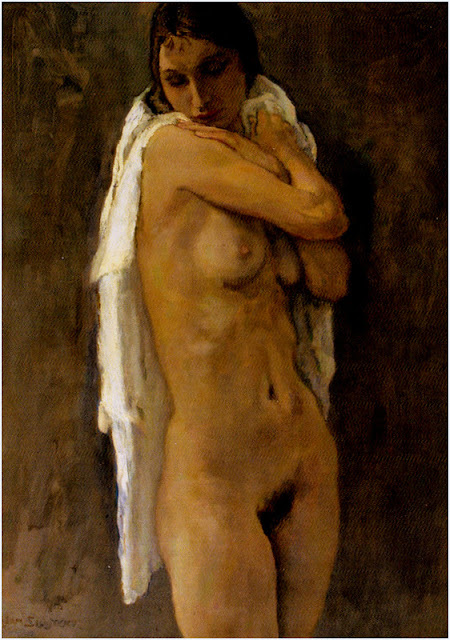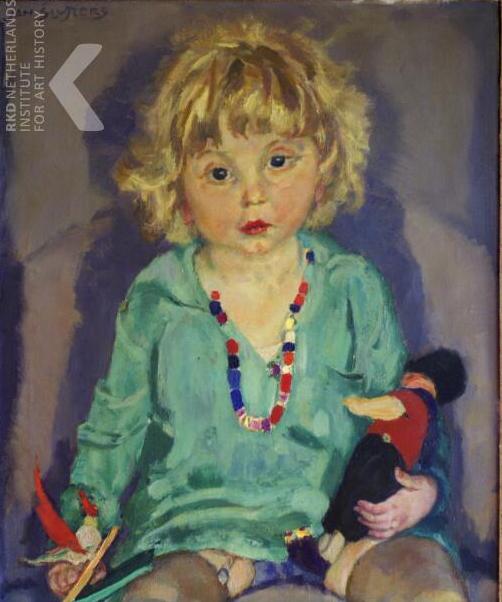 |
| Valentin Serov (Russian,1865–1911), Portrait of Yevdokia Sergeyevna Morozova, 1908, Oil on Canvas, 44.9 by 29.5 in., Tretyakov Gallery, Moscow, Russia |
 |
| Portrait of Princess Olga Orlova, 1911, Oil on Canvas, 93.7 by 63 in., State Russian Museum, St. Petersburg |
 |
| Portrait of Princess Olga Orlova, Detail |
 |
| Portrait of Henrietta Leopoldovna Girshman, 1907, Tempera on Canvas, 55.11 by 55.11 in., Tretyakov Gallery, Moscow |
 |
| Portrait of Henrietta Girshman, 1906, Tempera on cardboard, 39 by 26.8 in., Tretyakov Gallery, Moscow |
 |
| Portrait of Mara Konstantinovna Oliv, 1895, Oil on Canvas, 34.6 by 26.9 in., State Russian Museum, St. Petersburg |
 |
| Portrait of Maria Akimova, 1908, Oil on Canvas, 30.3 by 24.4 in., The Picture Gallery of Armenia, Erevan, Armenia |
 |
| Model with Her Hair Down, 1899, Watercolor and White on Paper, mounted on Cardboard, 52.4 x 35.5 cm., Tretyakov Gallery, Moscow |
It is truly astonishing to me that the Art Nouveau aesthetic,
which influenced or inspired the greatest portrait painters of the late 19th
and early 20th Centuries, is passé for portrait painters of the
early 21st Century. Despite paying
homage to Sargent, Zorn, Sorolla, Boldini, Kroyer, Klimt and many others, today’s
portrait painters avoid the flowing line, the elegance of pose and the expressive
feeling those masters captured on canvas.
All that really matters in the business these days is high-definition photographic
accuracy.
The accepted conventions of the past are now generally
ignored or poorly executed -- a tilt of the head, which is turned in opposition
to the torso; a facial expression of any kind, coordinated sensitively with all
the mobile features (eyes, eyebrows, nose and mouth); a pronounced placement of
the pose, whether linear or curvilinear, existing in dominant harmony with the
sitter’s environment.
I often reflect on this inexplicable rejection of grace and
beauty by today’s hard-working painters when an unfamiliar portrait by one of
the past masters of the art catches my eye as I ride herd on the vast Internet art
range, a poor metaphor that reminds me of a line from a sentimental cowboy song
written by Gene Autry: “Riding down the
canyon to watch the sun go down, a picture that no artist e’er could
paint.” The “Singing Cowboy” sure got
that one right.
But an artist was capable of creating the painting I
recently came across, and in such a fabulous manner that Mother Nature herself
would bow her head in humble submission.
It was the 1908 portrait of Yevdokia Sergeyevna Morozova, wife of the
art collector Ivan Morozova, and it was created by one of Russia’s
greatest painters, Valentin Serov (1865-1911).
After admiring the beautiful, vivacious face of this woman,
I noted the graceful position of her right forearm and skillfully cropped hand resting
upon her bosom. Perhaps this gesture is
too theatrical for today’s cynical world, but Serov found it an effective way
to add rhythmic movement to a pose, and he used variations of it for some of
his most important portraits of women, as well as for a couple of his famous portraits
of men.
It is a terrific way to handle painting of those appendages. Faces are a snap by comparison, and clients
are satisfied if you simply copy a flattering photograph exactly. But if you don’t give the arms at least a
slight bend at the elbow, you are better off keeping them covered with
sleeves. And if you don’t give the hands
a bit of a turn or something to do, they
are better off left in pockets than lying dead on the arms of a chair. Also, depicting one hand is usually enough
for any portrait. Serov knew that. So should everybody else.
Serov was trained as a realist, but he is said to have
worked very hard to achieve a look of “freedom, artistry, effortless ease” in
his paintings, eschewing any hint of photographic precision in the finished portrait.
“He painted his portraits slowly,
sometimes agonizingly,” wrote one critic.
Serov himself said, “Each portrait is for me an illness.”
I wonder if today’s digital toilers, working under the intense
glare of LED lights day and night, are able to empathize with Serov, who once
said:
Any human face is so
complex and so unique that you can always find in it traits worthy of
portrayal, be they good or bad. For my
part, each time I appraise a person’s face I am inspired, you might even say
carried away, not by his or her outer aspect, which is often trivial, but by [the]
characterization it can be given on canvas.
That is why I am accused of sometimes having my portraits look like
caricatures.”
And as often happens when a painter like Serov is “in the
zone” seeking some primal truth about the sitter, the resulting portrait often
ends up being as much about the emotional state of the painter as that of the
sitter.
Dmitry Sarabyanov, the author of a brilliant essay on Serov
in a 1982 catalog of the artist’s work published by Aurora Art Publishers, St.
Petersburg, Russia,
suggests that:
In Serov’s world the subject
of spiritual beauty in man was one of the most controversial. In the 1870s and 1880s [Ilya] Repin saw his
ideal in real persons. Unlike his
teacher, Serov looks for true beauty, a beauty inaccessible to an eye not
endowed with artistic vision; he seeks to fathom human emotions, to divine the human
drama involved. It is these aspirations
that brought Serov’s artistry into being, investing him with a penetrating insight
into nuances and minor details and an abhorrence for the insipid
“verisimilitude” that, in Serov’s opinion, destroys art.
Serov never depicts
character “in general.” He is interested
in a specific facet of that character, the all-important facet that most
tellingly reveals the aesthetic worth of the person portrayed. He uses all the pictorial possibilities of
the portrait – pose, gesture, composition, color scheme, the painterly style
itself – to bring out the aesthetic merit of the sitter in the most vivid
fashion.
From 1890 on, Serov’s portrait work was his most important
genre. His favorite models were actors,
artists, and writers, including Konstantin Korovin (1891), Isaac Levitan
(1893), Nikolai Leskov (1894) and Nikolai Rimsky-Korsakov (1898) -- all in the
Tretyakov gallery in Moscow. After 1900 he painted several outstanding
portraits in the grand manner, as well as intimate portraits of women and
children. In addition to oils, he worked
in tempera, watercolors, pastels and lithography.
Serov was a creative genius who bridged the gap between the
Russian Realists and the Russian modernists with his paintings. What bridges
are today’s portrait painters building with their fealty to pixel counts? Aw, who cares anyway? We’re heading more and more to a digital world
of virtual reality, where a retrograde painter’s vision of the natural world is
completely irrelevant.





























